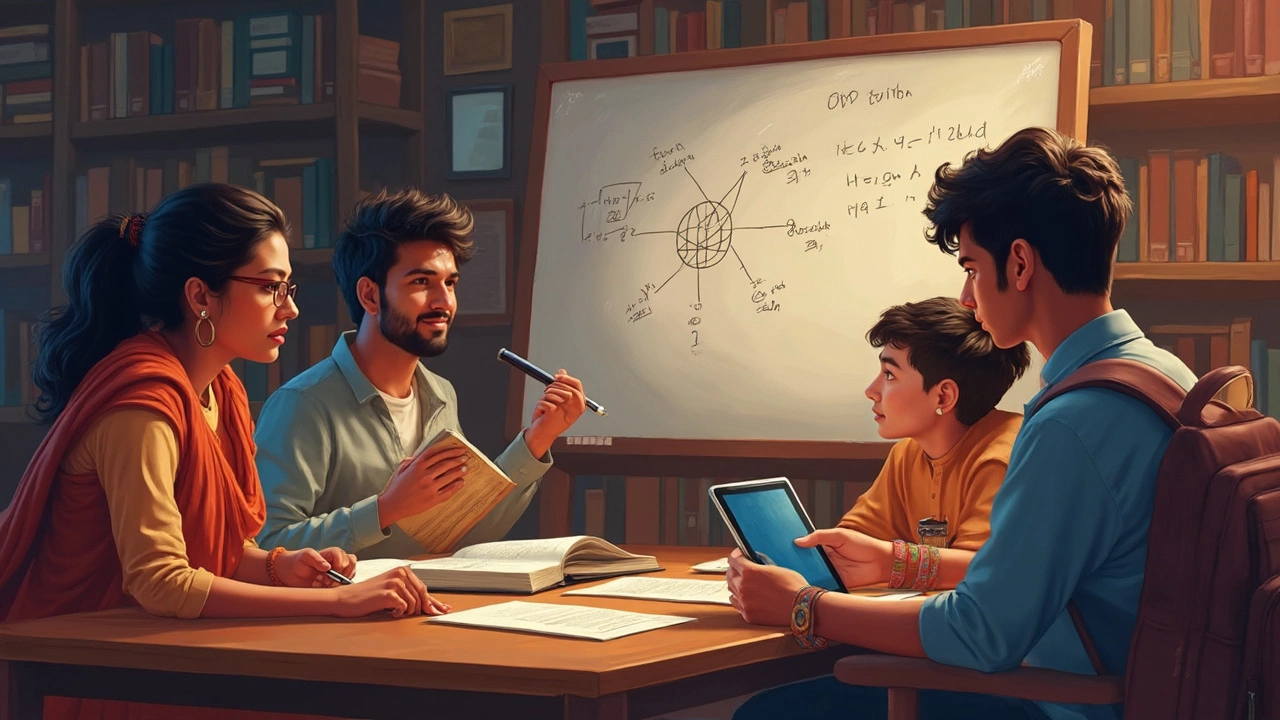Cracking NEET Physics feels tough even before you open a book. Most students run straight to DC Pandey, thinking it’s the holy grail for NEET prep. But is it really all you need? Tons of NEET aspirants ask this, and the answer isn’t just a simple yes or no.
DC Pandey’s series is everywhere— your seniors swear by it, coaching centers push it, even YouTubers keep it on their desks. Why? Because it explains concepts in a clear way and is packed with practice questions. But here’s the thing: NEET Physics isn’t just about solving a thousand problems. The exam mixes up basics with tricky concepts, and sometimes the actual paper looks nothing like the exercises you’ve been slogging through.
If you’re counting on DC Pandey alone to carry you to a NEET 170+ score in Physics, it’s time for a reality check. The book’s strengths are solid, sure, but NEET’s question-makers love to surprise you. Let’s break down what DC Pandey actually offers, where it comes up short, and what you need to do if you really want an edge over everyone else scrambling on exam day.
- What Makes DC Pandey So Popular for NEET?
- The Good and the Gaps: Where DC Pandey Helps (and Misses)
- Beyond DC Pandey: What Else Do You Need?
- Tips to Maximize Your Physics Prep for NEET
What Makes DC Pandey So Popular for NEET?
If you’re asking around for a good Physics book for NEET, you’ll hear DC Pandey’s name in about five seconds. It’s basically everywhere for one big reason: it’s built for exams. The NEET physics questions in DC Pandey look a lot like the actual pattern, so solving them gets your brain working the way it should for the real thing.
The explanations stand out. DC Pandey doesn’t just throw formulas at you—he actually breaks the concepts down first. If you hated Physics in school, you’ll probably find the language a lot easier here: simple steps, diagrams, solved examples, and logical order.
One of the biggest strengths is how he splits the questions by level. You start easy, build confidence, and then hit tougher, NEET-type questions. That way, you’re not overwhelmed right off the bat. Plus, there are special sections for past NEET/AIPMT questions. That’s a goldmine for spotting repeated topics and styles.
Here’s a quick look at why students love DC Pandey for NEET:
- Clear concepts and summary points for last-minute revision
- Practice questions grouped by difficulty
- Comes with short-cuts, tricks, and tips—especially in the ‘Objective’ sections
- Solutions and hints are detailed, so you’re not stuck guessing “why?”
- Units match exactly with the NEET syllabus, so nothing random is added
Check out the results of a quick survey done by an online student community for NEET prep in March 2024:
| Resource | Used by (%) | Preferred for Practice |
|---|---|---|
| DC Pandey | 83 | 73 |
| HC Verma | 69 | 38 |
| Coaching Module | 56 | 51 |
So, most NEET aspirants grab DC Pandey because the book actually targets the kind of questions NEET asks, and keeps it straightforward. It’s not perfect (no book is), but for building your foundation fast and getting exam-ready practice, it’s tough to beat.
The Good and the Gaps: Where DC Pandey Helps (and Misses)
If you’re prepping for NEET physics, DC Pandey’s books have some clear upsides. They break down tough concepts, offer illustrations, and have loads of solved examples. If you’re not a fan of dense theory or hate when a book just dumps formulas without any logic, DC Pandey is like that chill teacher who actually explains stuff. Most NEET coaching centers even list his book as must-read for building your basics.
The real pull for students? The variety and volume of practice questions. You’ll find everything: single correct, assertion-reason, and even statement-based questions. This helps you get used to the formats NEET likes. Also, short tricks and highlighted boxes make revision faster, especially during those last two crazy weeks before the exam.
Take a look at this quick breakdown of where DC Pandey stands out versus where it lags:
| Strengths | Gaps |
|---|---|
| Covers all NEET Physics chapters with clear explanations | Sometimes goes too deep, wasting time on non-NEET topics |
| Loaded with chapter-wise exercises and MCQs | Lacks enough NCERT-based factual questions asked in NEET |
| Tricks and shortcuts for quick problem-solving | Some solutions are skipped or not explained in detail |
| Great for building concepts and confidence | May not match NEET’s latest style or weightage exactly |
But here’s what many students miss: NEET rarely asks purely numerical questions unless you know the basics cold. If you only practice from DC Pandey, you might be blindsided by questions pulled straight from NCERT lines or conceptual statements you never saw before. Some NEET 2023 toppers admitted they got stuck because they ignored the factual, often confusing, one-liners—something DC Pandey just isn’t designed for.
If you feel lost after using the book, you’re not alone. It’s not that DC Pandey is bad; it’s just not a one-stop shop. The good stuff covers your problem-solving game and gets your basic concepts straight. The missing links? Not enough tough, NCERT-twisted questions and not enough focus on areas where NEET is changing and evolving. If you lean too much on this single resource, you’ll have serious FOMO on the exam paper.

Beyond DC Pandey: What Else Do You Need?
Depending only on DC Pandey is like turning up to a cricket match with just a bat. Sure, you’ll get runs, but it’s not enough to play the whole game. NEET expects you to handle standard questions and random curveballs, and sometimes DC Pandey just doesn’t cover those sneaky topics or exam tricks.
First, NEET physics often pulls questions straight from NCERT textbooks. Ignoring NCERT is almost asking to miss out on 30-40% of simple but direct questions. A 2023 analysis showed that nearly 36 out of 50 physics questions in NEET had their base in NCERT’s explanations or diagrams. It’s all about knowing what’s actually written, word for word.
It doesn’t stop there. Certain concepts—like semiconductors, communication, and practical experiments—are often brushed over in most guides. But in NEET 2024, for example, five questions were directly linked to these ignored areas. If you skip them, that could cost you 20 marks or more.
So here’s what else should definitely be in your prep toolkit:
- NCERT Textbooks: Don’t treat these as light reading. Memorize definitions, diagrams, and formulas. Even the footnotes sometimes turn up in the exam.
- Previous Year NEET Papers: These are a goldmine. You get to see the actual level and repeated patterns. Do at least the last 10 years. Check your mistakes and note the logic behind official answers.
- Mock Tests: Time-bound mock tests build real stamina. Don’t just do the test—analyze your silly errors, repeated mistakes, and timing issues.
- Formula Sheets and Short Notes: Toppers usually stick the most mixed-up formulas and short tricks on their wall. Reviewing them for fifteen minutes every night actually helps.
For reference, here’s how toppers stacked their practice sources, according to a 2024 poll of NEET 650+ scorers:
| Resource | Average % Used by Toppers |
|---|---|
| NCERT Textbook | 100% |
| Previous Year Papers | 95% |
| DC Pandey | 87% |
| Online Mock Tests | 76% |
| Other Reference Books (e.g., HC Verma) | 41% |
To sum it up, DC Pandey is great for drilling concepts and practicing questions, but skipping NCERT and mocks is risky. Mix up your resources like the toppers do, and you’ll see the difference by the time real NEET rolls around.
Tips to Maximize Your Physics Prep for NEET
Don’t treat DC Pandey as your only line of defense if you’re aiming for a high NEET Physics score. Here’s how toppers squeeze the most out of their prep without burning out.
- Start with NCERT First: Every NEET topper talks about this. The Physics section in NEET gets at least 60% of its questions directly or indirectly from NCERT. If you don’t understand a concept there, DC Pandey’s explanations won’t fill the gap.
- Mix Theory with Practice: Don’t just solve problems blindly. For every solved example in DC Pandey, check if you truly understand the reasoning. Swap between reading theory and practicing numerical questions—this keeps your brain sharp.
- Review Mistakes Fast: Mark wrong answers as you practice. Make a ‘mistake notebook’—it’s not old school, it works. Go through this book before every mock test and the real deal. This helps you remember your weak spots and avoid silly mistakes.
- Analyze Previous Year NEET Papers: Real NEET trumps any book. Solve actual NEET Physics questions from the last 10 years. Write down topics you see repeat, and focus on those chapters in DC Pandey.
- Time Your Tests: Don’t fall into the comfort zone of unlimited time. Give yourself 45 minutes for a 45-question section—just like the real NEET exam.
A quick look at real study data from the 2024 NEET toppers shows just how much time you should spend on each strategy:
| Strategy | Average Weekly Hours |
|---|---|
| NCERT + Class Notes | 6 |
| DC Pandey Solved Problems | 5 |
| Previous Year Papers | 3 |
| Mock Tests/Revision | 2 |
One more tip—a lot of students make the mistake of avoiding the tough chapters like Rotational Motion or Modern Physics. Don’t skip these. NEET loves to pull questions from places people neglect. If you feel stuck, look up video solutions or discuss with a buddy rather than leaving it out.



